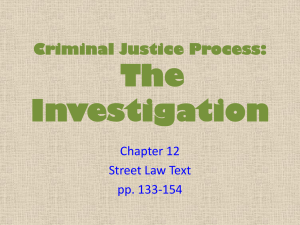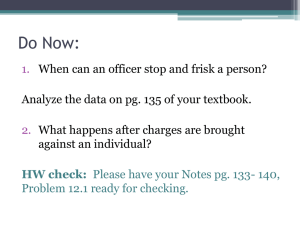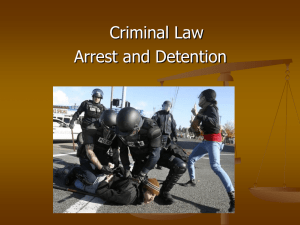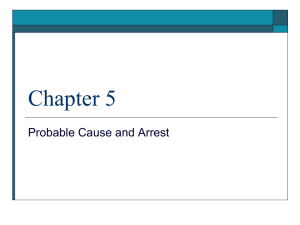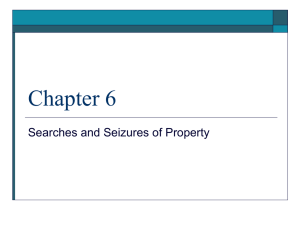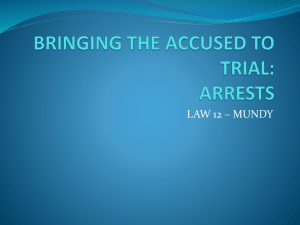Pros Clinic Outline
advertisement
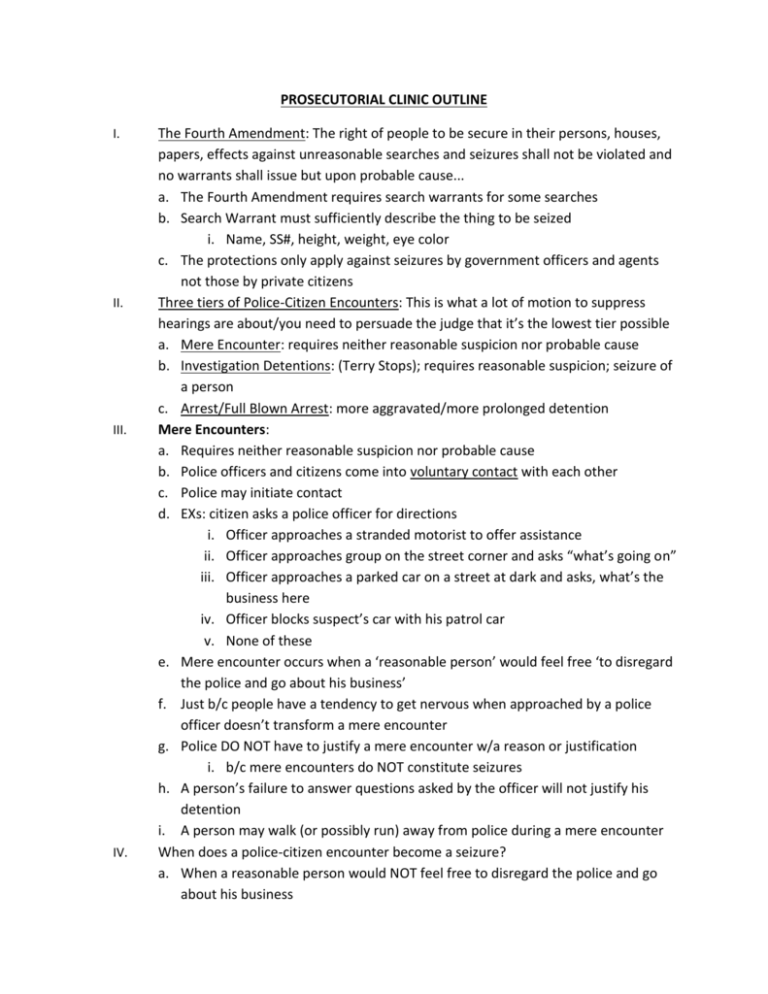
PROSECUTORIAL CLINIC OUTLINE I. II. III. IV. The Fourth Amendment: The right of people to be secure in their persons, houses, papers, effects against unreasonable searches and seizures shall not be violated and no warrants shall issue but upon probable cause... a. The Fourth Amendment requires search warrants for some searches b. Search Warrant must sufficiently describe the thing to be seized i. Name, SS#, height, weight, eye color c. The protections only apply against seizures by government officers and agents not those by private citizens Three tiers of Police-Citizen Encounters: This is what a lot of motion to suppress hearings are about/you need to persuade the judge that it’s the lowest tier possible a. Mere Encounter: requires neither reasonable suspicion nor probable cause b. Investigation Detentions: (Terry Stops); requires reasonable suspicion; seizure of a person c. Arrest/Full Blown Arrest: more aggravated/more prolonged detention Mere Encounters: a. Requires neither reasonable suspicion nor probable cause b. Police officers and citizens come into voluntary contact with each other c. Police may initiate contact d. EXs: citizen asks a police officer for directions i. Officer approaches a stranded motorist to offer assistance ii. Officer approaches group on the street corner and asks “what’s going on” iii. Officer approaches a parked car on a street at dark and asks, what’s the business here iv. Officer blocks suspect’s car with his patrol car v. None of these e. Mere encounter occurs when a ‘reasonable person’ would feel free ‘to disregard the police and go about his business’ f. Just b/c people have a tendency to get nervous when approached by a police officer doesn’t transform a mere encounter g. Police DO NOT have to justify a mere encounter w/a reason or justification i. b/c mere encounters do NOT constitute seizures h. A person’s failure to answer questions asked by the officer will not justify his detention i. A person may walk (or possibly run) away from police during a mere encounter When does a police-citizen encounter become a seizure? a. When a reasonable person would NOT feel free to disregard the police and go about his business V. b. Courts will often find a seizure based upon an officers: i. Show of authority (words or actions) ii. Application of physical force c. Examples: i. Officer says “stop right there” 1. Seizure, verbal show of authority ii. Blue lights or siren, or raises hand to signal stop 1. Non-verbal show of authority iii. Grabbing arm and he attempts to walk away 1. Physical application of force iv. Officer blocks suspect’s car with his patrol car Investigation Detentions a. Terry v. Ohio: i. Plain clothes police officer observed two men on a street corner; The officer observed each man walk past and peer into a store b/4 returning to the corner to talk; The officer suspected that the men were 'casing' the store for a robbery and he feared that they might be armed ii. He approaches them; terry and cohort mumbled responses to the questions officer grabbed terry and patted down his outer clothing searching for weapons iii. When the officer felt what he believed to be a pistol, he removed terry's coat and found a pistol iv. Terry was arrested for carrying a concealed weapon v. Terry's motion to suppress the piston was denied and he was convicted vi. ISSUE: Did the officer's seizure of Terry and subsequent search of his person violate the 4th amendment? vii. HELD: 1. Police may seize a person for investigative purposes and w/o probable cause provided that they have reasonable suspicion of criminal activity 2. When police have reason to believe that a seized person is armed and dangerous, they may conduct a limited pat down or frisk (search) for weapons 3. Justification was officer protection b. Need reasonable suspicion for a Tier 2; Terry detention i. What suspicions would be deemed reasonable? 1. More than a hunch or a gut feeling but less than probable cause 2. Reasonable suspicion that criminal activity is afoot 3. An officer must be able to articulate some basis for the seizure – reasonable, articulable suspicion 4. Seizure can’t be merely arbitrary or harassing 5. Officer doesn’t have to erase history, that is part of reasonable suspicion (ex: if they are a drug dealer or known criminal history) c. How long may a person be “detained” during a 2nd Tier encounter: i. Must be brief, last no longer than necessary to effectuate their purpose and terminate once the suspicion has been dispelled ii. No bright line rule. Case by case determination d. May a lawfully detained person refuse to give name or answer questions? It depends i. In a tier 2 encounter, the failure to give one’s name or answer questions may result in an arrest or prolonged detention ii. The detained person cannot walk or run away e. The officer may use as much force as is reasonably necessary to protect his personal safety and to maintain the status quo while completing tier 2 investigation VI. Tier 3 arrest: How is arrest defined? a. Temporary detention is not an arrest b. A “formal arrest” occurs when an officer communicates his intent to take a suspect into custody to answer to criminal charges. “you’re under arrest” c. An involuntary trip to the station will almost always constitute an arrest d. Courts apply an objective test to determine whether a reasonable person would feel so restrained as to equate his detention with a formal arrest. e. Examples: i. Officer tells suspect...'your under arrest' ii. Officer aims pistol and says "get down on the ground" iii. Officer completes investigation -- handcuffs suspect and places him back of car iv. Officer details driver of a car 45 minutes while waiting for the arrival of a drug dog f. NOTE: there is no bright line rule to determine when an investigative detention becomes an arrest...case by case basis **A person is not under arrest until he: 1) Is under the physical control of police 2) Submits to their show of authority g. Need probable cause to make an arrest Probable Cause: fair probability that a suspect is committing or has committed a crime a. It’s an objective standard: When known facts and circumstances based upon reasonably trustworthy information would warrant a reasonable man to conclude that a suspect is committing or has committed a crime b. A judge will decide if, based upon the totality of circumstances, a fair probability of guilt existed c. The standard is not a preponderance of the evidence, but it’s more than a mere suspicion or possibility d. Police may rely upon his own senses: sight, hearing, touch, taste, smell e. May be premised on trustworthy hearsay f. Police may rest upon collective knowledge g. Miranda does not have to be read every time an officer comes in contact with a suspect, only if a suspect is in custody VIII. Cases a. Davis v. State: i. Officer approaches group of guys in drug area ii. Court asks, would a reasonable person believe that they were required to stay? iii. CoA thought tier 1 iv. Officer asked, do you mind if I search you; they agreed, evidence found— suspect charged v. Court says suspect wasn’t seized so it search was voluntary b. Young v. State: i. Did the officer have reasonable suspicion? 1. Didn’t see the driver commit any traffic violations and the only reason he stopped the car was to see if the lawnmower was stolen ii. Court says this was a hunch and you need more than a mere hunch iii. Officer must point to specific and articulable reasons ** The sliding scale b/t mere encounters, investigative detentions and arrests is not reducible to a mathematical formula, it’s a case by case determination** IX. The Exclusionary Rule: a judicially created deterrent to police misconduct that results in the suppression of illegally seized evidence a. This is why the distinction b/t the 3 tiers is so important, b/c evidence maybe seized during any of the 3 tiers of police-citizen contact and evidence that is unlawfully seized at any of the three tiers may be suppressed b. If the stop was illegal, then all evidence gathered is fruit of the poisonous tree and must be suppressed VII. X. c. Only applicable to governmental action d. If neighbor finds m/j plants and turns them in...that's lawful e. The mere fact of an illegal search or seizure does not prevent a criminal prosecution. (The success of that prosecution will depend upon the strength of the remaining admissible evidence) f. What kinds of evidence might be suppressed? i. Tangible or physical evidence obtained DIRECTLY as a result of an unlawful seizure Blood evidence, drugs . Derivative evidence: the so-called "fruit of the poisonous tree" obtained indirectly as a result of an unlawful seizure Admissions, confessions, etc. g. There are exceptions: i. Impeachment: if the D lies about the existence of suppressed evidence on direct, he may be impeached on cross ii. Attenuation: may become admissible if the taint of illegality dissipates over time iii. Independent source: seizure of evidence based upon independently gathered info apart from and untainted by earlier illegal methods iv. Inevitable discovery: would have been discovered eventually through lawful means v. Good faith: not applicable in GA; if the police reasonably relied on a judge’s finding of probable cause Terry Frisks a. An officer may conduct a protective pat down (frisk) to discover weapons if he has reason to believe (ie reasonable suspicion) that a person is armed and dangerous b. NOTE: An anonymous tip will ordinarily not provide sufficient trustworthy information to justify a stop and frisk c. A Terry frisk is NOT authorized merely to discover evidence of illegal conduct or contraband d. Common Terry Frisk factors: i. Excessive nervousness, belligerent attitude ii. Furtive movements, attempts to conceal objects, hands in pockets, etc. iii. Bulges in clothing iv. High crime area (not enough in and of itself, but can be a factor) v. Time of night e. Generally, the frisk or pat down must be of the outer clothing only f. Under the plain feel exception, however, an officer may seize non-weapons whose evidentiary significance is immediately apparent i. Can't manipulate the item ii. Very few police officers can actually do this iii. This is a rarely used exception!!!!! g. If D will try to get evidence excluded w/a Motion to Supress h. NOTE: if the officer detects an object that feels like a weapon may he reach inside and seize it i. If it turns out to be contraband, instead of weapon, it has nonetheless been lawfully seized ii. Credibility determination iii. IF YOU HAVEAN OFFICER SAY THAT HE KNEW IT WAS COCAINE/MJ THEN YOU ARE IN TROUBLE i. Terry searches may also extend to areas w/n the suspect’s immediate control, including the passenger compartment of his car Searches Incident to Arrest: I. When an officer makes a lawful arrest, he may make a warrantless search of: a. The arrestee’s person b. The area w/n the arrestee’s IMMEDIATE control c. Broader than a weapons search II. Justifications: a. The exception to the warrant requirement is to: i. Protect arresting officers from readily accessible weapons ii. Prevent the destruction of evidence iii. Remove possible means of escape III. A person under lawful arrest may be searched from head to toe including any containers in his possession a. But they cannot search the house if an individual is arrested in his home; you need a search warrant to do that b. Police may conduct a protective “sweep” of the premises where the arrest takes place to ensure officer safety i. Legitimately looking for co-defendants ii. Scope of protective sweep is really anywhere a person could fit IV. Upon arrest of any occupant of a car, an officer may search the entire passenger compartment, including closed containers, but not the trunk V. The fact that a car’s occupant is arrested, handcuffed, and separated from the car doesn’t prevent a lawful search of the passenger compartment “incident to arrest” VI. A search incident to arrest must be “substantially contemporaneous” with the arrest itself VII. Before police may conduct a search incident to arrest, they must actually take the person into custody a. Show of authority b. Application of physical force Warrants I. Arrest Warrant: a. Should be issued by a neutral and detached judicial officer b. The quantum of evidence required to establish probable cause of a warrantless arrest is greater than that required for an arrest warrant c. Probable cause that: i. Crime has been committed ii. That a named person committed it d. Private citizens may apply for arrest warrants e. Affadavit or oral testimony provides probable cause for arrest warrant f. Warrantless Arrests: i. Whether an arrest warrant is needed depends on where the person is ii. Public Places: 1. US v. Watson – arrest made at restaurant w/o warrant 2. If supported by probable cause, an arrest in a public place doesn’t require a warrant even if time would have permitted the officer to obtain one 3. Applies to misdemeanors and felonies alike 4. Georgia courts have held that an arrest and search legal under federal law are legal under state law iii. Houses: 1. Payton v. NY – arrests made in a person’s home must generally be based upon an arrest warrant 2. w/an arrest warrant, police may enter a home if they reasonably believe: a. It belongs to the named suspect b. The suspect is present in the home 3. Three Notable Exceptions: a. Consent; permission to enter by an authorized occupant b. Exigent Circumstances: i. Entry necessary to protect officers or others ii. Entry necessary to prevent destruction of evidence c. Hot pursuit: i. Continuous chase ii. US v. Santana – doorway was a public place 4. Some Courts characterize ordering a person out of home as a constructive entry iv. Warrantless home entries are presumed unreasonable 1. Police must demonstrate exigent circumstances 2. Gravity of the underlying offense v. Warrantless entry to arrest for traffic misdemeanor is not justified g. Third Parties: i. Police need a search warrant if police attempt to arrest a person in someone else’s home ii. The police should generally knock and announce his authority unless apparent, and state the charge 1. Magistrate may issue no knock warrants if police can demonstrate danger iii. An Officer may use such force as is reasonably necessary to effect the arrest 1. May not use deadly force unless the officer reasonably believes that the suspect is armed or poses an immediate threat of bodily harm to the officer or others 2. No right to resist a lawful arrest h. A private citizen may arrest an offender for a crime committed in his presence II. Need probable cause to also receive a search warrant Miranda Rights: o o o o o o o I. You have the right to remain silent Anything you say can and will be used against you in a court of law You have the right to talk to a lawyer and have him present with you while you are being questioned If you cannot afford to hire a lawyer, one will be appointed to represent you before any questioning, if you wish You can decide at any time to exercise these rights and not answer any questions or make any statements Do you understand each of these rights I have explained to you? Having these rights in mind, do you wish to talk to us now? Historical Background: a. Brown v. MS: confessions can’t be extracted by coercion or brutality b. Escobedo v. IL: The 6th amendment may be invoked pre-trial too, if requests access to counsel, should be given c. Miranda v. Arizona: Prosecution must use procedural safeguards effect to secure the privilege against self-incrimination to use statements stemming from custodial interrogation d. Person must be warned that he has the right to remain silent, hat any statement he does make may be used as evidence against him, and that he has a right to the presence of an atty, either retained or appointed II. i. The D may waive...these rights, providing the waiver is made voluntarily, knowingly, and intelligently ii. Likewise if the individual is alone and indicates in any manner that he does not wish to be interrogated [to remain silent], the police may not question him Miranda applies if: a. b. c. d. e. The suspect was in custody The suspect is subjected to interrogation ONLY APPLIES TO CUSTODIAL INTERROGATIONS Miranda Warnings need only be given before Tier 3 questioning Jackson-Denno Hearing: determines whether a person is in custody for Miranda purposes prior to formal arrest i. Police aren’t required to administer Miranda rights to everyone they question 1. Even if the questioning takes place at the police station 2. Even if the person is a suspect 3. EX: field sobriety tests don’t require Miranda to be read 4. A witness in front of the grand jury isn’t entitled to Miranda warnings even if the witness is a target of the investigation ii. Officers subjective intent to arrest is irrelevant unless that intent is conveyed to the suspect by word or deed f. Interrogation occurs: i. Express questioning ii. Functional equivalent attempt to elicit incriminating information from a suspect in custody 1. Volunteered statements of any kind aren’t barred by the 5th amendment and their admissibility isn’t affected if Miranda isn’t read g. Custodial Interrogation: i. Questioning initiated by law enforcement officers after a person has been taken into custody or otherwise deprived of significant freedom ii. Formal arrest is the clearest case iii. Custody is an objective standard 1. Reasonable person doesn’t mean person w/a guilty conscience h. Common Non-Interrogation situations: i. Terry stops and frisks ii. General on-the-scene questioning iii. Questioning a suspect not yet taken into custody iv. Routine traffic stop v. Field sobriety vi. Don't have a duty to prevent a defendant from talking about the criminal incident if the D wishes to do so; they must not interrogate, but they need not refuse to listen vii. Emergency public safety inquiries are not considered interrogations i. Once a suspect invokes Miranda, all questioning must stop immediately i. Only a D may invoke Miranda, not his atty or his family ii. Unless the suspect initiates further communications with police iii. Invocation to remain silent, isn’t a blanket prohibition against all subsequent questioning by police 1. Ex: questioned 2 hours later by different officers about a different crime ***A custodial statement isn’t admissible unless: (1) The D was adequately warned; his rights were read and explained to him (2) D knowingly, intelligently j. Valid Waiver of Miranda: i. D was adequately warned, rights were read and explained ii. D knowingly, intelligently, and voluntarily waives those rights Miranda Compliance I. Anytime a D makes a statement, the Court has to determine if that statement is admissible at a Jackson-Denno a. Pre-trial or in the middle of the trial b. Outside of the presence of the jury II. Was the suspect in custody? a. If no, then Miranda doesn’t apply III. Miranda Compliance: a. Were the Miranda rights read and explained to the D prior to his giving the statement? i. Precise language of Miranda not required so long as warnings reasonably convey core 5th amendment rights b. Prosecution must show that the waiver was voluntary i. No intimidation, coercion, deception, and made with full awareness of rights being abandoned ii. Not required to waive in writing, oral waiver is sufficient TIP: The best evidence of a D’s waiver of his Miranda rights is a signed Miranda waiver form iii. Police may not question first Mirandize later IV. Voluntary confession/statement: a. Not induced by i. Slightest hope of benefit ii. Remotest fear of injury Jackson-Denno Hearings: I. II. III. IV. V. State introduces evidence to show that the D’s statement was given voluntarily, and where applicable, that the statement was preceded by Miranda warnings and a waiver of rights After the state rests, the D is then entitled to introduce evidence to rebut the State’s case a. D has the right to testify but cannot be forced b. If D chooses to testify, such testimony may be used later to impeach trial testimony c. If the D chooses to testify, he may not be cross-examined on issues of guilt or innocence d. D is entitled to have all witnesses present when he gave the statement at the Jackson-Denno **TIP: this is why police should exclude all non-essential personnel from the interrogation room Judge must make several findings: a. Was Miranda applicable? i. Was the D’s statement the product of a custodial interrogation b. Was Miranda complied with? i. Were the rights read and explained c. Did D waive them? i. D knowingly, intelligently, and voluntarily waive Miranda rights **Burden of Proof is on the State d. Judge must look at the totality of the circumstances e. Preponderance of the evidence After the Court rules: a. A D’s statement may be introduced i. By having a witness testify to what was said ii. By reading it if it was written iii. Playing it or showing it to the jury if video ***NOTE: A D’s written, audio, or video statement may not go out with the jury*** b. A D’s waiver form, however, may go out with the jury c. NOTE: a search warrant may be predicated on a suspect’s voluntary, but unlawfully obtained statements D’s Silence: a. May not be used against a suspect at trial b. Can’t be used by the State to impeach volunteered trial testimony c. NOTE: testimony regarding a suspect’s midstream invocation of his right to remain silent/right to counsel may sometimes be permitted if it merely ‘marks the termination of permissible evidence” d. TIP: it is vitally important that the state present evidence of Miranda compliance and voluntariness in front of the jury Initial Appearance: I. Accused’s face-to-face encounter with a judicial officer following arrest a. May also serve as a non-adversarial probable cause hearing if the accused was arrested w/o a warrant b. Police making an arrest w/o a warrant shall bring the person arrested, w/o delay, before a judicial officer w/n 48 hours of the arrest c. Police making an arrest WITH a warrant shall bring the person arrested before a judicial officer w/n 72 hours after the arrest d. NOTE: obtaining an arrest warrant w/n 48 hours after a warrantless arrest eliminated the necessity for a probable cause hearing e. Failure to meet these 48/72 hour deadlines may result in the release of the person arrested i. The remedy here is release from custody f. The judicial officer shall: i. Inform the accused of the charges g. Explicit request for appointed counsel made to a judicial officer does invoke the right to counsel II. Does every arrested person get an initial appearance? a. NO, most D’s “bond out” prior to their initial appearance. When you bond out you waive right to initial appearance III. What happens at the initial appearance? a. The judicial officer shall: i. Inform the accused of the charges ii. Inform the accused of his Miranda rights iii. Determine whether the accused desires an appointed attorney and if so, inform the accused of the application process iv. In the case of a warrantless arrest, make a fair determination of probable cause v. Inform the accused of his right to a later probable cause hearing. vi. Inform the accused of his right to a grand jury indictment or an accusation vii. Inform the accused of when the next grand jury will convene viii. Inform the accused of his right to a jury trial ix. Inform the accused of his right to waive all rights and plead guilty Bail/Bond: I. What is bail: the release of someone (an accused) from jail prior to the resolution of the charges pending against him II. NOTE: Courts must often strike a balance b/t these two conflicting purposes for bail III. BAIL BOND: the surety or security for guaranteeing a released prisoner’s return for trial a. 5 KINDS: i. Cash Bond: Accused pays entire amount of bail set in cash ii. Surety Bond: accused pays 10% of bail set, bond company posts the balance iii. Property Bond: owner of property pledges the equity in their property in an amount equal to the bail set iv. Signature bond: (unsecured) accused signs promissory note to pay amount of bail set if he fails to appear v. Recognizance bond: accused signs non-monetary promise to appear b. Common Scenarios: i. Dollar amount of the bond is set on the arrest warrant when issued by magistrate ii. Bond amount is determined by reference to a bail schedule adopted by the local magistrate; (restricting use of bond schedules for domestic violence, gang activity, vehicular homicide, etc. -- these probably need to go in front of a judge) 1. OR, bond amount is set by the magistrate at the first appearance 2. Serious offenses are bailable only before superior court judge c. NOTE: Posting of bond is a waiver of the accused statutory right to a preliminary hearing IV. D makes a petition for bail/a motion for bail V. Criteria for granting bail: 1. Poses no significant risk of fleeing from the jurisdiction or failing to appear 2. Poses no significant threat or danger to any person, to the community, or to any property in the community 3. Poses no significant threat of committing any felony pending trial 4. Poses no significant risk of intimidating witnesses or otherwise obstructing the administration of justice VI. Defense attorney will typically emphasize the “roots in the community” and “presumption of innocence” a. Length of residence in the community b. Family ties to the community c. Employment status and history d. Past history of responding to legal process (failures to appear) e. Lack of criminal history VII. Prosecutor will emphasize the accused’s lack of roots in the community and other factors: a. Danger to the community i. Heinous nature of the crime ii. Incentive to flee iii. Lack of stability iv. Criminal history v. Witness intimidation VIII. D has the burden of proof showing that he meets the criteria for release, especially that he doesn’t impose a flight risk a. Judge may require D to avoid contact w/the victim, submit to drug and alcohol testing, or impose a curfew IX. Bail amount need not necessarily be w/n the D’s means as long as its reasonable a. May not be excessive b. D may always re-petition the court to reduce the amount of bond if he is unable to make the original bond c. Bail may be denied altogether/no constitutional right to bail d. If bail is denied, the judge must set forth his reasons so that an appellate court can determine whether there has been an abuse of discretion e. Denial of bail will not be set aside on appeal unless there is a manifest and flagrant error f. Person charged with misdemeanor shall not be refused bail g. A trial judge may revoke bond if following a hearing, it is shown that a D has violated a condition of his bond Preliminary Hearing: I. Wages case: fight over the dog that neighbor ran over; owner of dog cursed out the neighbor’s wife; wife gets a warrant for abusive and obscene language a. Preliminary Hearing: i. ADA gave owner an ultimatum to stop communication II. Preliminary Hearing: a. Post-arrest, pre-trial proceeding to determine if sufficient evidence exists to justify holding the accused for prosecution b. Bound over if there is probable case c. Even if case is dismissed, the charges can be revived (by new arrest warrant or an indictment) III. IV. V. VI. d. Primary purpose here is to release someone who is being held w/o probable cause e. From a D’s perspective, preliminary hearings are an opportunity for an accused to learn about the case i. Full adversarial hearing f. If an accused posts bond then his statutory right to a preliminary hearing is waived g. Sometimes a DA will allow a preliminary hearing if D wants one h. Once DA is indicted, no longer entitled to a preliminary hearing i. Court may grant habeus corpus if you don’t have a preliminary hearing w/n a reasonable time j. Preliminary hearing is a critical stage at which D is entitled to aid of counsel i. If denied and D can show prejudice he may be entitled to relief ii. May expose witnesses, create impeachment material, preserve favorable testimony, get a good idea o f how strong state’s case is k. Can take place in superior, state, probate, magistrate, and municipal courts – usually magistrate Judicial officer shall: a. Explain the probable cause purpose of the hearing b. Repeat rights explained at initial appearance, ie miranda, etc. c. Determine if accused intents to plea or waive right to prelim, if so bind case over d. If not immediately proceed to hearing, unless witness can’t show e. Cause an accurate record of the proceeding to be made f. Bind over the case or dismiss the case based on presence or absence of probable cause g. Forward a memorandum of commitment to the appropriate court (state/suprerior) Make sure that you request that the judge bind the charges over Rules of evidence apply; except hearsay may be allowed Accused shall be allowed to present evidence GRAND JURY: I. Have to establish probable cause at grand jury and guilt beyond a reasonable doubt to indict II. GA does create a narrow class of felonies that may be prosecuted on accusation w/o explicit waiver a. DA may proceed on accusation only if a preliminary hearing has been held or waived (bond) III. Grand Jury Qualifications: a. b. c. d. e. f. g. h. i. j. e. f. g. h. i. GA/US citizen 18 years old Competent Resident of the county for at least 6 months “most experienced, upright, and intelligent” citizens of the county Must select a “fairly representative cross section” of the citizens of the county i. Race (definitely) ii. Sex/gender (definitely) iii. Age (maybe) Grand jury consists of 23 persons w/16 present to constitute a quorum Need a vote of 12 to indict Secrecy: i. Applicable to the prosecutor and the grand jurors but not to witnesses who appear and give testimony ii. Prevents escape of targeted defendants iii. Prevents undue influence from being exerted on grand jurors iv. Encourages witness candor v. Protects innocent persons who are investigated Grand Jury duties i. Periodically inspect the jail ii. Periodically examine county offices iii. Prepare and issue civil presentments iv. Subpoena power over witnesses and documents and non-compliance may be punished by contempt DA’s role i. Advisor ii. Prepares criminal calendar iii. Drafts the indictments DA may not remain in the GJ room during deliberations Case presentation (informal) i. One or more state witnesses ii. DA examines witnesses on the facts iii. GJ may question witness iv. DA explains the law v. GJ votes in secret 1. No transcripts of GJ testimony True bill or no bill Hearsay is admissible VI. i. Exclusionary rule doesn’t apply, thus suppressible evidence may be presented (but probably shouldn’t be) ii. Not required to present exculpatory evidence to the grand jury Present and Former Police Officers a. Right to advance notice of charges b. Right to appear before the grand jury c. Right to make a sworn statement not subject to cross d. Right to be present during the presentation of all evidence and testimony i. ONLY FOR POLICE OFFICERS e. The grand jury must be persuaded at a minimum that there is probable cause to believe that the accused is guilty
